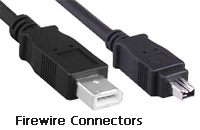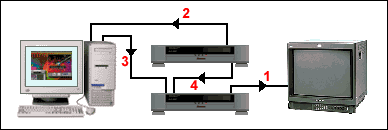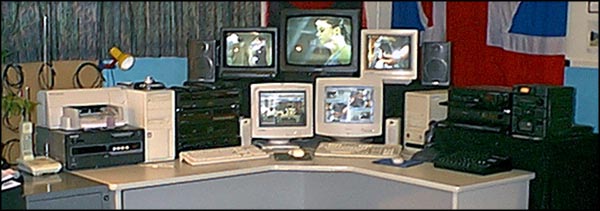Setting Up a Non Linear Edit Suite
To edit video on a computer you will need:
- A source device to play the original tape or disk. Typically a VCR or camera.
- A computer with at least these specs: 200 MHz processor / 64 MB RAM / Fast hard drive
with 1 GB or more free space.
Note: If you want decent results, you'll need much higher specs. Some editing software requires a high-performance computer to even work properly. - A video capture device. To capture video from an analogue source (such as VHS or Video8) you need a device to convert the video into a digital format. This can be a standalone device which plugs into the computer or a video capture card which becomes part of the computer.
If you are using a source device which outputs a digital signal (such as Firewire or USB) you don't need a capture device, but you do need to make sure your computer has the appropriate input available. - Connecting leads to plug the source device into the capture device or computer.
- Software to control the capturing, editing and outputting.
- A video monitor (or television).
We'll come back to the software on the next page. First, let's have a look at the hardware and physical connections. There are various options depending on your equipment.
Camera and Computer

The most common system in non-professional situations is to plug your video camera directly into your computer via a digital cable such as Firewire or USB. These connections and allow you to "dump" footage straight from the camera to the hard drive. This is a convenient and inexpensive way to operate. Consult your camera manual for details.
If your camera doesn't have a digital output, but does have analogue AV outputs, you can use a capture device. Follow the next example, using your camera in place of the VCR.
If your camera doesn't have any video outputs at all, you will need to use a VCR as the source device.
Computer and VCR
The example below shows a VCR used as the source device, connected to a computer with capture card. A video monitor (or television) is used to monitor the pictures. Audio can be monitored with the TV speakers, a separate sound system or headphones.

- If the VCR has two or more AV outputs, use one of them to plug into the AV input of the monitor. If you have only one AV output, use the RF (aerial) output instead, and use the AV output for the next step.
- The second AV output of the VCR plugs into the AV input of the computer's capture card.
- The AV output of the capture card plugs into the AV input of the VCR.
In this system, footage is played from the VCR to the computer, edited, then played back from the computer to the VCR (for recording).
Computer and Two VCRs
This system is slightly more elaborate, and has advantages such as the ability to record directly from one VCR to the other (linear editing). Also, if the computer has the appropriate hardware, you can use it to overlay graphics in real time as you record from one VCR to the other.

The top VCR is the source device; the bottom VCR is the recorder.
- The AV output of the record VCR plugs into the AV input of the monitor.
- The AV output of the source VCR plugs into the AV input of the computer's capture card.
- The AV output of the capture card plugs into the AV input of the record VCR.
- The second AV (or RF) output of the source VCR plugs into the second AV (or RF) input of the record VCR.
On the record VCR, select the appropriate input to record from either the computer or the source VCR.
Note: You could also use the second (or third) AV output of the source deck to feed another video monitor.
Example of a home-based edit suite
The example below is rather outdated but the same principles apply to more modern systems. This example incorporates both consumer-level and professional equipment. It can be used for editing home movies, DVDs, television-quality productions, and authoring internet material (more info). If you want to be adventurous, the possibilities are endless.

Next Page: Video Editing Software